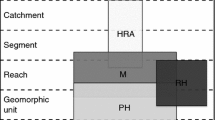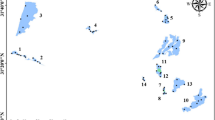Abstract
The selection of a reliable inference model is a crucial step in developing ecologically sound reconstructions of environmental variables in the past. We compared intra- and inter-regional regression-based models, and an inter-regional Modern Analogue Technique (MAT) model in their ability to infer lakewater pH from scaled chrysophyte assemblages. The performance of each model was assessed by examining cross-validated coefficients of determination and prediction errors, and through reconstructing the pH of ≈50 modern and fossil samples in south-central Ontario, Canada. Using the intra- and inter-regional data sets, we found little difference in the ability of the regression-based models to infer present-day pH. Partial Least Squares (PLS) regression, Weighted Averaging (WA), and Weighted Averaging Partial Least Squares (WA-PLS) inference models showed similar values for jack-knifed coefficients of determination (r2 jack), root mean squared errors of prediction (RMSEPjack), and mean and maximum biases. Based on an analogue matching approach, the inferred values from 48 fossil sediment samples suggested that the intra-regional model did not provide reliable reconstructions for approximately half of the fossil samples. However, inferences from the inter-regional MAT and regression-based models were found to have appropriate analogues and thus considered to be more reliable.
Similar content being viewed by others
References
Bartlein P.J. and Whitlock C. 1993. Paleoclimatic interpretation of the Elk Lake pollen record. In: Bradbury J.P. and Dean W.E. (eds), Elk Lake, Minnesota: Evidence for Rapid Climate Change in the North-Central United States. Geol. Soc. Am., Boulder, CO, USA Special Paper 276, pp. 275–293.
Birks H.J.B. 1994. The importance of pollen and diatom taxonomic precision in quantitative paleoenvironmental reconstructions. Rev. Palaeobot. Palynol. 83: 107–117.
Birks H.J.B. 1995. Quantitative palaeoenvironmental reconstructions. In: Maddy D. and Brew J.S. (eds), Statistical Monitoring of Quaternary Science Data. Quaternary Research Association, Cambridge Technical Guide 5, pp. 161–254.
Birks H.J.B. 1998. Numerical tools in palaeolimnology-Progress, potentialities, and problems. J. Paleolim. 20: 307–322.
Birks H.J.B., Line J.M., Juggins S., Stevenson A.C. and ter Braak C.J.F. 1990. Diatoms and pH reconstruction. Phil. Trans. Royal Soc. London B327: 263–278.
Bray J.R. and Curtis J.T. 1957. An ordination of the upland forest communities of Southern Wisconsin. Ecol. Monogr. 27: 325–349.
Cumming B.F. and Smol J.P. 1993. Scaled chrysophytes and pH inference models: the effects of converting scale counts to cell counts and other species data transformation. J. Paleolim. 9: 147–153.
Cumming B.F., Smol J.P. and Birks H.J.B. 1992a. Scaled chrysophytes (Chrysophyceae and Synurophyceae) from Adirondack drainage lakes and their relationship to environmental variables. J. Phycol. 28: 162–178.
Cumming B.F., Smol J.P., Kingston J.C., Charles D.F., Birks H.J.B., Camburn K.E. et al. 1992b. How much acidification has occurred in the Adirondack region (New York, USA) since preindustrial times? Can. J. Fish. Aquat. Sci. 49: 128–141.
Dixit S.S., Dixit A.S. and Smol J.P. 1989a. Lake acidification recovery can be monitored using chrysophycean microfossils. Can. J. Fish. Aquat. Sci. 46: 1309–1312.
Dixit S.S., Dixit A.S. and Smol J.P. 1989b. Relationship between chrysophyte assemblages and environmental variables in seventy-two Sudbury lakes as examined by canonical correspondence analysis (CCA). Can. J. Fish. Aquat. Sci. 46: 1667–1676.
Dixit S.S., Dixit A.S. and Smol J.P. 1992. Assessment of changes in lake water chemistry in Sudbury area lakes since preindustrial times. Can. J. Fish. Aquat. Sci. 49: 8–16.
Dixit S.S., Dixit A.S. and Smol J.P. 1999. Lake sediment chrysophyte assemblages from the northeastern USA and their relationship to environmental variables. J. Phycol. 35: 903–918.
Jeffries D.S. and Snyder W.R. 1983. Geology and geochemistry of the Muskoka-Haliburton study area. Data Report DR 83/2. Ontario Ministry of the Environment (unpublished).
Glew J.R. 1988. A portable extruding device for close interval sectioning of unconsolidated core samples. J. Paleolim. 1: 229–234.
Hall R.I. and Smol J.P. 1996. Paleolimnological assessment of long-term water-quality changes in south-central Ontario lakes affected by cottage development and acidification. Can. J. Fish. Aquat. Sci. 53: 1–17.
Line J.M., ter Braak C.J.F. and Birks H.J.B. 1994. WACALIB version 3.3: a computer program ro reconstruct environmental variables from fossil assemblages by weighted-averaging and to derive sample-specific errors of prediction. J. Paleolim. 10: 147–152.
Lotter A.F., Walker I.R., Brooks S.J. and Hofmann W. 1999. An intercontinental comparison of chironomid palaeotemperature inference models: Europe vs North America. Quat. Sci. Rev. 18: 717–735.
Olander H., Birks H.J.B., Korhola A. and Blom T. 1999. An expanded calibration model for inferring lakewater and air temperatures from fossil chironomid assemblages in northern Fennoscandia. Holocene 9.3: 279–294.
Prentice I.C. 1980. Multidimensional scaling as a research tool in Quaternary palynology: A review of theory and methods. Rev. Palaeobot. Palynol. 31: 71–104.
Siver P.A. 1995. The distribution of chrysophytes along environmental gradients: their use as biological indicators. In: Sandgren C.D., Smol J.P. and Kristiansen J. (eds), Chrysophyte Algae: Ecology, Phylogeny and Development. Cambridge University Press, Cambridge, UK, pp. 232–268.
Siver P.A., Lott A.M., Cash E., Moss J. and Marsicano L.J. 1999. Century changes in Connecticut, U.S.A., lakes as inferred from siliceous algal remains and their relationships to land-use change. Limnol. Oceanogr. 44: 1928–1935.
Smol J.P. 1995. Applications of chrysophytes to problems in paleoecology. In: Sandgren C.D., Smol J.P. and Kristiansen J. (eds), Chrysophyte Algae: Ecology, Phylogeny and Development. Cambridge University Press, Cambridge, UK, pp. 303–329.
ter Braak C.J.F. 1995. Non-linear methods for multivariate statistical calibration and their use in palaeoecology: a comparison of inverse (k-nearest neighbours, partial least squares and weighted averaging partial least squares) and classical approaches. Chem. Int. Lab. Sys. 28: 165–180.
ter Braak C.J.F. and Juggins S. 1993. Weighted averaging partial least squares regression (WA PLS): an improved method for reconstructing environmental variables from species assemblages. Hydrobiologia 269–270: 485–502.
ter Braak C.J.F. and Šmilauer P. 1998. Canoco reference manual and user's guide to Canoco for Windows: Software for canonical community ordination (version 4). Microcomputer Power, Ithaca, NY, USA, 352 pp.
Walker I.R., Levesque A.J., Cwynar L.C. and Lotter A.F. 1997. An expanded surface-water palaeotemperature inference model for use with fossil midges from eastern Canada. J. Paleolim. 18: 165–178.
Author information
Authors and Affiliations
Corresponding author
Rights and permissions
About this article
Cite this article
Paterson, A.M., Cumming, B.F., Dixit, S.S. et al. The importance of model choice on pH inferences from scaled chrysophyte assemblages in North America. Journal of Paleolimnology 27, 379–391 (2002). https://doi.org/10.1023/A:1016046005623
Issue Date:
DOI: https://doi.org/10.1023/A:1016046005623




